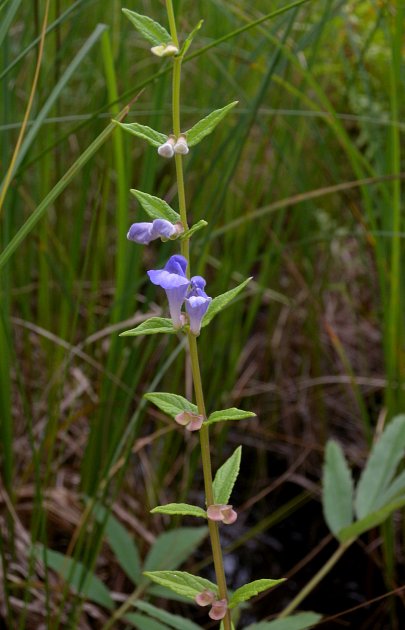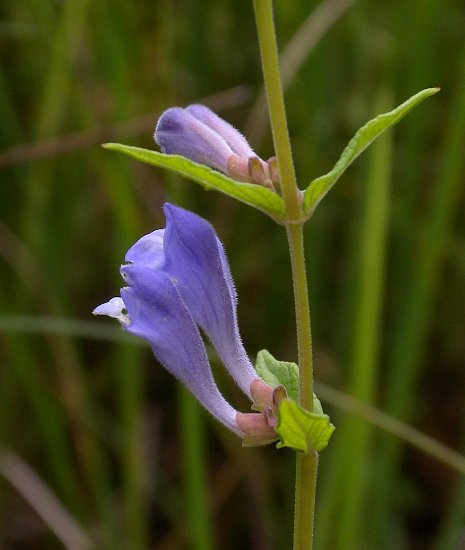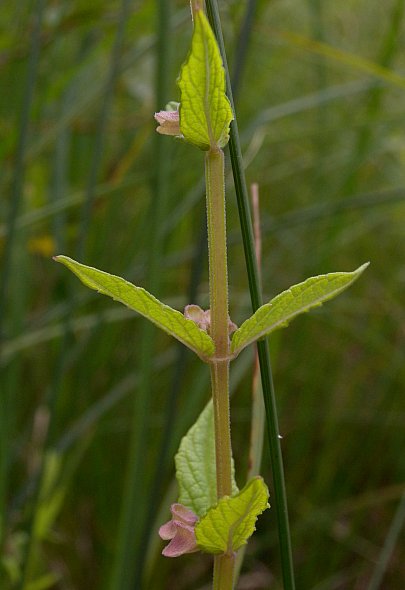
Each flower is about ¾–1" long, consisting of a tubular 2-lipped corolla, a short 2-lipped calyx, 4 inserted stamens, and an ovary with an inserted style. The corolla is ascending, becoming wider toward its outward-facing lips; it is predominately blue, becoming whitish toward its base and inside its throat. The upper lip forms a skull-shaped hood, while the lower lip forms a broad landing pad for flower-visiting insects. The exterior of the corolla (especially above) has short fine pubescence. The calyx is light green to yellowish red and finely pubescent; on its upper side, there is an oblique dish-shaped appendage. The blooming period occurs from mid- to late summer, lasting about 1-2 months. There is no noticeable floral scent. Afterwards, each flower is replaced by a small capsule containing up to 4 nutlets; this capsule eventually splits open, ejecting the nutlets. The root system is fibrous and stoloniferous, often forming small colonies of clonal plants.
Cultivation: The preference is full sun to light shade, wet conditions, and soil containing sand, muck, or peaty material. Shallow water is readily tolerated. This plant could be cultivated in wetland gardens.

Range & Habitat: The native Marsh Skullcap is occasional in northern and west-central Illinois, while in the rest of the state it is absent (see Distribution Map). Illinois lies along the southern range-limit of this species. Marsh Skullcap also occurs in Eurasia; it is usually found in boreal regions. Habitats include marshes, sandy marshes, borders of small ponds or slow-moving streams, peaty bogs, openings in swamps, wet thickets, ditches. These habitats often occur in sandy areas. This plant is found in higher quality natural areas.
Faunal Associations: Like other skullcap species (Scutellaria spp.), the flowers of this plant are probably cross-pollinated by long-tongued bees. The endangered Karner Blue Butterfly (Lycaeides melissa samueilis) and probably other butterflies also visit the flowers for nectar, but they are less effective at cross-pollination. Larvae and adults of the leaf beetles, Phyllobrotica limbata and Phyllobrotica decorata, feed on Marsh Skullcap; this plant is reportedly the favorite host of the latter leaf beetle. Some species of micromoths, including Prochoreutis inflatella (Skullcap Skeletonizer Moth), also feed on the leaves of skullcaps (Grundel & Pavlovic, 2000; Clark et al, 2004; Panzer et al., 2006). Because Marsh Skullcap has bitter foliage and it occurs in relatively inaccessible locations, it is probably not browsed to any significant extent by mammalian herbivores.

Photographic Location: A sandy marsh at Illinois Beach State Park in NE Illinois.
Comments: Marsh Skullcap has fairly showy flowers. It can be distinguished from other skullcap species (Scutellaria spp.) in Illinois by the following combination of features: 1) only solitary axillary flowers are produced, rather than terminal racemes of flowers, 2) the flowers exceed ½" in length, 3) the leaves are fairly narrow in shape (less than 1" across), and 4) it is found in wetlands, rather than drier areas of woodlands and prairies. The common name, 'skullcap,' for this group of wildflowers may refer to the shape of the upper lip of their flowers. A scientific synonym of Marsh Skullcap is Scutellaria epilobiifolia.